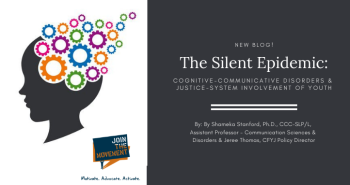The Silent Epidemic: Cognitive-Communicative Disorders & Justice-System Involvement of Youth

Every year over 75,000 youth under 18 are prosecuted as adults in the criminal justice system. Although judicial waiver is used in less than 5% of all cases when youth are tried as adults, this data is collected routinely at the federal level, making it easiest to track. Youth transferred by juvenile court judges are disproportionately black and male. There is also research to suggest that these youth are disproportionately impacted by mental health needs. While the intersection of mental health, trauma, and justice-system involvement have been explored over the last decade, one connection that has not been fully examined is the difference between cognitive-communicative disorders and mental health; and the confluence of cognitive-communicative disorders and disproportionate justice-system involvement for black youth.
What is a Cognitive-Communicative Disorder?
Cognitive-Communicative Disorders (CCD) are deficits or specific impairments that impact an individual’s attention, memory, problem solving ability, emotional functioning, comprehension and production, literacy, pragmatics, social skills, and expressive and receptive language (American Speech-Language-Hearing Association, 1993). CCD can impact an individual’s communication and comprehension status in a way that affects their ability to fully participate in all aspects of life including social, vocational, and educational endeavors.
What are the common traits of youth with communication disorders and how are those traits interpreted by authority figures: teachers, police, etc?
CCD can impair a youth’s ability to functionally recall information, follow directions, and academically succeed. When a CCD is undiagnosed, or lacks proper treatment, academic and vocational impacts persist throughout the child’s life into adulthood (Stanford & Muhammad, 2018). Specifically, a child’s literacy skills, behavioral skills, social and pragmatic skills, decision making skills, and expressive and receptive language skills are negatively impacted. Thereby, often leading to long-term detrimental effects such as: 1) maladaptive behaviors and impulsivity; 2) limited education; 3) exacerbated mental health and learning disabilities; and 4) increased future involvement in the criminal justice system (Nance, 2016).
How are black youth impacted by communication disorders specifically?
Although African-Americans comprise only 13% of the United States population, they are 5.1 times more likely to be incarcerated in state prisons. Black males ages 18 and 19 are 11.8 times more likely to be in prison than their white peers. This was the age group with the highest racial disparity in 2016. The reasons for this mass incarceration are complex, the social, historical, and systemic impact of racism in the United States has exacerbated poverty and the availability of community resources in Black communities. More specifically, Black youth who reside in low socioeconomic communities have a history of decreased access to routine and specialized health and academic care of which can impact early diagnosis and early intervention of CCD; and assessment, treatment and intervention. Therefore, factors that impact quality of life such as a lack of resources to address cognitive-communicative disorders (CCD) can be exacerbated by the barriers already present within their communities. Barriers such as adverse childhood experiences, exposure to familial substance abuse, domestic violence, educational limitations, and increased contact with the criminal justice system (directly or indirectly secondary to family members). As a result, CCD can impair a youth’s ability to functionally recall information, follow directions, increase vocabulary skills, maintain a topic, problem solve, critically think, read social cues, recognize and control maladaptive behaviors. Furthermore, left untreated, may lead to a young person appearing non compliant with conditions of release, or in an out of home placement.
Further, Black youth with CCD have higher rates of struggling in school, dropping out of school, and being expelled from school for status offenses. As a result, Black youth with CCD generally demonstrate the most difficulty with educational attainment, academic success, and literacy skills. This increases their probability of personally interacting with the criminal justice system and entering society with significantly higher incarceration rates (Stanford & Muhammad, 2018). In 2016, Black youth were approximately 14 percent of the population, but over 51 percent of the youth transferred to adult criminal court by juvenile court judges.
Recommendations for the Field
It is critically important that justice system stakeholders are aware of how CCD impact youth’s problem solving, critical thinking skills, and impulsivity. Specifically youth with atypical cognitive, speech and/or language development. This is especially important for youth of color with undocumented and undiagnosed CCD secondary to their decreased access to treatment and intervention, and increased risk of disproportionate contact with the adult criminal justice system.
Public defenders and criminal defense attorneys should consider resourcing speech and language pathologists to conduct evaluations and assessments related to the presence, impact and severity of cognitive-communicative disorders. This is particularly important during the process of determining if youth should be considered for transfer to the adult criminal justice system by a juvenile court judge or being considered for reverse waiver by an adult court judge.
It is important for a Speech and Language Pathologist to be the professional source utilized to rule out or determine the severity and impact of the cognitive-communicative disorder in youth charged with a criminal offense because of their extensive education, knowledge, and clinical experience focused on speech, language, and cognitive related disorders. More specifically, it is the expectation of the Speech and Language Pathologist to recognize, assess, and treat the significant impact of atypical speech, cognition, and language productions on an individual’s quality of life and/or academic success.
Understanding the manifestation of CCD and increasing access to treatment for all youth, but particularly for Black youth, is critical to keeping young people in school and out of the juvenile and adult criminal justice system.

